Sri Lanka's property prices continue to rise!
Property prices continue to rise in Sri Lanka, as the security situation stabilises. There’s no official house price data in Sri Lanka, but developers and homebuyers confirm there have been double-digit property price rises in recent years. The value of apartments in the secondary market has risen more than 100% in the past 3 to 4 years, say local real estate analysts. Land prices in residential areas of Colombo, the capital, have gone through the roof.
However, a period of high inflation and higher construction costs mean that the real rise in property values is less than appears.
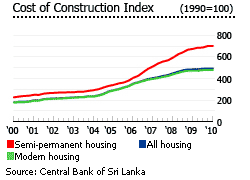
The long run of price increases dates back to the 2001 ceasefire, which led to a surge in investments by overseas Sri Lankans - working in the US, Australia, Canada, UK, and the Middle East. More than 50% of Colombo’s condominium buyers are overseas Sri Lankans.
The housing boom has of course excluded foreigners, who since 2004 have been required to pay a 100% tax on landed properties purchased in Sri Lanka. The 100% surcharge is also imposed on apartments below the 4th floor.
AVERAGE PROPERTY PRICES PER REGION(AS OF MARCH 2010) |
||||
| REGION | HOUSE PRICE | LAND PRICE (PER PERCH) | ||
| LKR | USD | LKR | USD | |
| Colombo | 32.7 million | 293,888 | 3.2 million | 28,760 |
| Western Province (apart from Colombo) | 13.3 million | 119,532 | 507,828 | 4,564 |
| Southern Province | 11.5 million | 103,355 | 188,009 | 1,690 |
| Central Province | 12.2 million | 109,646 | 264,899 | 2,381 |
| North West Province | 15.3 million | 137,507 | 228,575 | 2,054 |
| North Central Province | 5.8 million | 52,127 | - | - |
| Uva Province | 6.7 million | 60,216 | - | - |
| Sabaragamuwa Province | 4.1 million | 36,848 | 480,000 | 4,314 |
| Eastern Province | 11.2 million | 100,659 | 123,909 | 1,114 |
| North Province | 3.1 million | 27,861 | 220,000 | 1,977 |
| Source: Lanka Property Web | ||||
In March 2010:
- The average sale price of houses in Sri Lanka was LKR13.8 million (US$124,026), according to Lanka Property Web, one of the country’s leading property portals.
- The average price of apartments was LKR12.5 million (US$112,342).
- The average price of land was US$183 per sq. m. or LKR514,086 (US$4,620) per perch in March 2010 (1 perch = 25.29 sq. m.).
The 3-decade civil war has ended
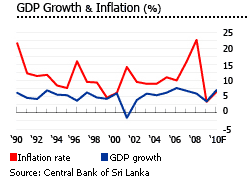
The civil war in Sri Lanka has lasted 30 years. Nine years ago there was hope that it would end soon, with the 2001 ceasefire agreement with the Liberation Tigers of Tamil Eelam (LTTE). Confidence in the economy revived, and there was strong demand for luxury apartments from expatriates who had left during the intense fighting. Developers experienced lucrative profit margins. Local investors followed, as these properties earned high yields.
However in November 2005, the conflict resumed when Mahinda Rajapaksa was elected president. A strong supporter of a unitary state, Rajapaksa swore to defeat the Tamil Tigers. In 2006, the ceasefire totally collapsed, with bombings and attacks on government officials. But while the housing market lost its momentum, values remained high.
After intense fighting the LTTE’s main stronghold was captured and its leaders killed, with talk of a massacre by government forces. In May 2009, Rajapaksa officially declared the end of the insurgency.
In January 2010, Rajapaksa was re-elected to a second and final six-year term as president. His closest challenger was Gen. Sarath Fonseka, the Armed Forces Chief (who ran a campaign criticizing the Rajapaksa’s authoritarianism). Fonseka was defeated, court martialled, imprisoned, and stripped of all military ranks.
Demand for housing rising!
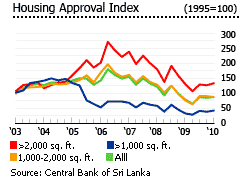
Economic growth is returning. The Sri Lankan economy is likely to grow by 7.5% to 8% in 2010, more than double 2009’s 3.5% GDP growth rate, according to the Central Bank (CBSL). The forecast is supported by robust domestic demand and strong consumer and investor confidence, following the end of the 3-decade civil war.
From 2003 to 2008, the country experienced impressive average annual GDP growth of 6.3%.
There’s now a severe housing shortage, which could reach 650,000 units in 2010, in a country of around 5 million households, according to the Ministry of Housing and Plantation Infrastructure.

A fall in housing construction approvals in recent years exacerbated the situation. In Greater Colombo, approvals plunged 28.1% in 2009 to 7,890 units, after a decline of 22.4% in 2008 and a drop of 10.6% in 2007. The drop in approvals is attributable to rising construction costs, corruption and red tape, and security problems.
About 76% of the total housing stock in Sri Lanka is owner-occupied. Around 90% is single houses. Annual housing demand is estimated at around 80,000 to 100,000 units.
Inflation down, interest rates down!

The housing loan interest rate was slashed to 12% in May 2010, from a high of 20% in October 2009, by the Bank of Ceylon, Sri Lanka’s largest bank, following a decline in inflation. The Central Bank of Sri Lanka’s reverse repo rate was 9% in November, the lowest for six years.
Inflation was 6.6% in October 2010. Consumer prices rose by just 3.4% in 2009, down from an annual average of 12.6% from 2001 to 2008.
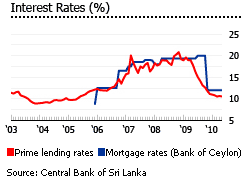
Private commercial banks, which control about 75% of the market, offer adjustable-rate mortgage loans, introduced earlier during the high-inflation era. State-owned banks usually offer fixed-rate mortgage loans. Lanka’s mortgage market is very small - around 3.5% of GDP in 2009. Mortgage loan maturities range from 15 to 25 years. The average commercial bank loan is LKR1 million (US$8,987); state-owned company loans are on average smaller.
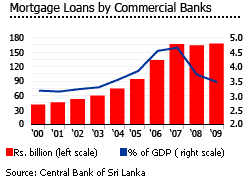
The rental market is dominated by the luxury segment
Sri Lanka’s small rental market - only 5.4% of the total housing stock is rented - is dominated by high-end luxury apartments. The market for middle- and low-income renters is almost non-existent.
In recent years rents have risen by an average of 11% annually, according to local real estate analysts. Average rental yields are about 5% to 6%, according to local developers. These yields are low, considering the 10.6% prime lending rate and mortgage interest rates of around 12%.
Economic growth is hotting up
The Sri Lankan economy is expected to grow by 7.5% to 8% in 2010, more than double 2009’s 3.5% GDP growth rate, based on CBSL estimates. From 2003 to 2008, the country experienced impressive economic growth, with average annual GDP growth of 6.3%, after a disastrous high-debt episode in 2001.
In 2009, the budget deficit was 9.9% of GDP, but the government promises to reduce it to 8% of GDP in 2010 and 5% of GDP in 2012.
Tourism is expected to boom

In 2010, tourist arrivals are expected to reach 600,000, up from 447, 890 in 2009. To boost tourism, the government has legalized gambling despite religious protests. The return of peace is likely to bring a ‘peace dividend’ in the tourism sector.